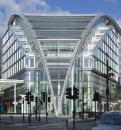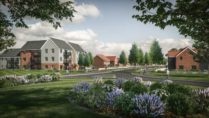Harlow & Gilston Garden Town
Having chaired the first-morning session, Michael Hardware went on to present in the second session, introducing the Harlow & Gilston Garden Town, the unsung hero of the east of England.
Michael is the cabinet member for economic development at Harlow District Council and sits on the board of the Harlow & Gilston Garden Town. The Garden Town is a pioneering partnership between five councils; two counties and three districts. Its initial objective is to facilitate the delivery of 16,000 by 2033 in ‘greater’ Harlow – with the existing 36,000 homes, that represents growth of 44% in 10 years which makes Harlow one of the fastest growing, if not the fastest growing area of the country.
There are also aims to create 20,000 jobs and to regenerate the town centre. A network of Sustainable Transport Corridors will be assisting in facilitating a 60% modal shift away from the car to cycling, walking and public transport.
Harlow currently faces significant challenges which the Garden Town will address: it needs a critical population mass to grow and sustain services, employment and a thriving town centre; its highway network is at capacity; it has an ageing housing stock; there are visible signs of deprivation; a shortage of affordable housing, and; there is a significant skills shortage.
The Garden Town emerged from a ‘duty to cooperate’ with a successful bid for Garden Town status in 2017 in recognition of the joint working and potential to accelerate growth. Currently, there is an informal delivery partnership board, soon to move to a formal Joint Committee. This will share risk and accountability and provide strong leadership, governance and transparency.
The population grew by 11,000 between 2011 and 2021 to 93,300. It is set to grow by a further 25,700 to 119,000 in the next 10 years to 2033. Employment growth is expected to be 23% in the same period.
Investment in the town is already substantial including £85million for a new junction on the M11, which was completed last year, £171million Housing Infrastructure Grant to facilitate the Gilston villages infrastructure, £820million for a new hospital and medical campus, and £100million for the regeneration in the town centre including the Towns and levelling Up funds, and the Harlow Investment Fund.
Housing investment will also see developer contributions to the Sustainable Transport Corridors, bus service enhancements, libraries, the culture quarter, rugby facilities, youth facilities, two new leisure centres, a new community sports hall, public art, cycleways, 13 new primary schools, five new secondary schools and four new community halls.
Harlow is set to grow significantly in the coming years, but it has in place the investment for the associated infrastructure to ensure the town can cope with the growth. Key to the growth, however, is the integration of the new communities with the existing ones, ensuring it is cohesive. These are considerations now, during master planning, not after work is underway!
The town also sits in the ‘core’ of the UK Innovation Corridor, linking Cambridge with London, similarly one of the fastest growing areas in the UK, so the future for Harlow looks promising.

Strategic land and site promotion
“Chelgate gives a real insight into political thinking at all levels and all political persuasions, …

Energy and infrastructure
From new nuclear and unconventional gas to renewables, waste and airports, our team has worked …

